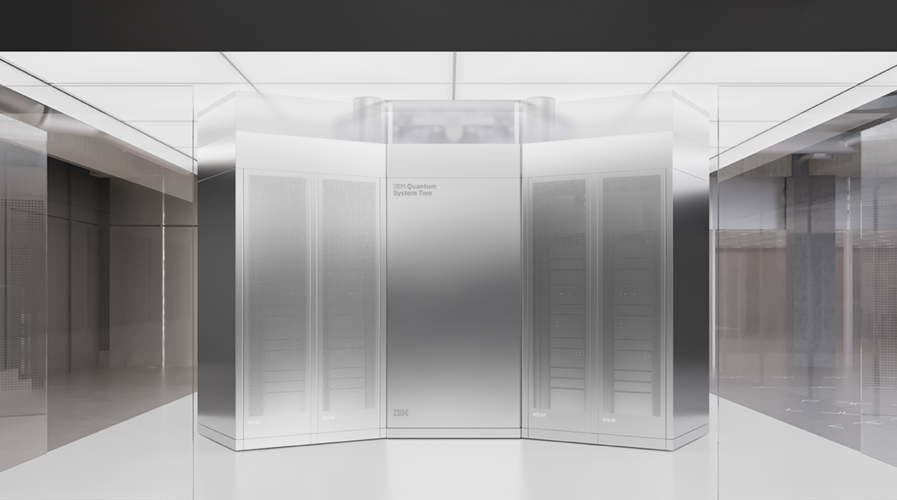
IBM Quantum System Two, visually rendered here, is a system designed to be modular and flexible, combining multiple processors into a single system with communication links. (Credit: IBM)
IBM’s US$100 million quest to build a 100,000-Qubit Quantum-Centric Supercomputer
|
Getting your Trinity Audio player ready... |
When it comes to quantum computing, IBM continues to lead innovations and development in the technology. Having recently unveiled the IBM Quantum Safe Roadmap in tandem with a suite of technologies to secure critical data from potential future threats, IBM is now moving towards quantum-centric supercomputing.
Quantum-centric supercomputing is an entirely new and unrealized era of high-performance computing. A 100,000-qubit system would serve as a foundation to address some of the world’s most pressing problems that even the most advanced supercomputers of today may never be able to solve.
Building this system is no easy task. Hence, IBM has announced a ten-year, US$100 million initiative with the University of Tokyo and the University of Chicago to develop a quantum-centric supercomputer powered by 100,000 qubits. The partnership will see the two universities and IBM works over the next decade to advance the underlying technologies for this system, as well as to design and build the necessary components at scale.
A 100,000-qubit system could unlock entirely new understandings of chemical reactions and the dynamics of molecular processes. In turn, this could enable researchers to help study climate change by modeling better methods to capture carbon; discover materials to build batteries for electric vehicles and energy grids towards the goal of being cleaner and more sustainable; and uncover more effective and energy-efficient fertilizers.
Apart from the two universities, IBM also intends to expand these partnerships to include Argonne National Laboratory and Fermilab National Accelerator Laboratory, both of which are members of the Chicago Quantum Exchange and home to two respective Department of Energy quantum hubs. Importantly, the two laboratories offer capabilities and expertise that can facilitate delivering the technologies envisaged in the race to build a quantum-centric supercomputer.

A 100,000-Qubit Quantum-Centric Supercomputer. (Source – IBM)
For Arvind Krishna, Chairman and CEO of IBM, the company has been at the forefront of introducing quantum technology to the world over the past several years.
“We have achieved significant progress along our roadmap and mission to globally establish useful quantum technology, so much so that we can now, with our partners, truly begin to explore and develop a new class of supercomputing anchored by quantum.”
A quest for quantum computing and IBM
To build the quantum-centric supercomputer, the plans are expected to involve innovations at all levels of the computing stack and encompass the convergence of the fields of quantum computing and quantum communication, as well as the seamless integration of quantum and classical workflows via the hybrid cloud.
Because such a computer has never been made before, the first step will be to lay out a blueprint. The design will have to integrate classical computers and quantum computers – a challenging task to date – as well as break new ground in quantum communication and computing technology.
The foundation of this system will include milestones IBM has already outlined on its Quantum Development Roadmap. This includes the ability to scale and connect growing numbers of quantum processors through quantum interconnects, as well as technology to mitigate errors to fully harness noisy yet powerful quantum processors.
IBM also intends to debut three cornerstones of its necessary architecture for quantum-centric supercomputers by the end of 2023. They include:
- A new 133-qubit ‘IBM Heron’ processor – this processor is a complete redesign of IBM’s previous generations of quantum processors, with a new two-qubit gate to allow higher performance. It will also be compatible with future extensions to enable modular connected processors to grow the size of the computer.
- The introduction of IBM Quantum System Two – the new flagship system is designed to be modular and flexible to introduce elements of scaling in its underlying components, including classical control electronics and high-density cryogenic wiring infrastructure. This system is targeted to be online by the end of 2023.
- The introduction of middleware for quantum – a set of tools to run workloads on both classical and quantum processors. This includes tools for decomposing, parallel execution and reconstructing workloads to enable efficient solutions at scale.
Over the next decade, IBM plans to work with university partners and its worldwide quantum computing ecosystem to evolve how its quantum processors can be connected via quantum interconnects. This work will aim to enable high-efficiency, high-fidelity inter-processor quantum operations and a reliable, flexible, and affordable system component infrastructure to allow scaling to 100,000 qubits.
READ MORE
- Safer Automation: How Sophic and Firmus Succeeded in Malaysia with MDEC’s Support
- Privilege granted, not gained: Intelligent authorization for enhanced infrastructure productivity
- Low-Code produces the Proof-of-Possibilities
- New Wearables Enable Staff to Work Faster and Safer
- Experts weigh in on Oracle’s departure from adland


